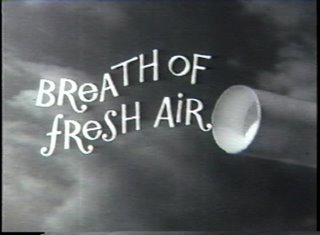Reviews of film ephemera, including such things as educational films, industrial films, military and propaganda films, tv commercials, movie trailers, shorts, experimental films, and movies made for non-mainstream audiences.
BBC1 Schools Interval from 1975 (film #9 in the Schools section of TVArk). [Category: Educational]
A still title card announces that the next show will be starting soon, while Dixieland jazz plays in the background. This is a realistic example of what educational television stations broadcast between programs at the time, but it’s not very interesting to watch.Ratings: Camp/Humor Value: *. Weirdness: **. Historical Interest: ***. Overall Rating: **.
A Communications Primer (film #360 on Prelinger Archive). [Category: Educational]
This film was made by Charles and Ray Eames, which makes it more intelligent and visually striking than most educational films. It deals with the semantics of communication, breaking down the concept into a flow chart of choosing, coding, sending, receiving, decoding, and understanding messages. This is applied to modes of communication as simple as “one if by land and two if by sea” and as complex as billions of neurons firing in the human nervous system. Visually, these concepts are portrayed with a collage of animation, film clips, photographs, electronically-generated images, and images from famous works of art. Aurally, they are portrayed with deadpan narration and a haunting music score by Elmer Bernstein. This film is to films like Communications and Our Town, as 2nd-grade social studies is to a graduate-level course in philosophy. But at heart, it’s still an educational film, so it still qualifies as ephemera, though smarter than your average piece of ephemera. The Eames were key players in the modernist design movement, giving this film a great deal of historical value.Ratings: Camp/Humor Value: *. Weirdness: ****. Historical Interest: *****. Overall Rating: ****.
Burns & Allen Show #3 (film #3 on Side A of Disc #4 of TV Favorites DVD Megapack (Treeline Films, 2003)). [Category: Early Film & TV]
More silliness with George Burns and Gracie Allen. This one has the fluffiest of plots involving Harry Morton’s secretary making Blanche jealous, until she finds out he’s a man. Mostly, though, this is gags aplenty, Gracie’s illogical logic, and Bill Goodwin’s bizarre Carnation commercials that are woven into the action. There’s a real vaudeville and radio feel to this one, making it a good example of early TV.Ratings: Camp/Humor Value: ****. Weirdness: *****. Historical Interest: *****. Overall Rating: ****.

Belair Commercials Compilation #1 (film #159 on UCSF Tobacco Control Archive). [Category: Commercial]
Collection of dorky early-60s commercials for Belair cigarettes, mostly featuring groups of very white people partying by singing Belair jingles, which is at least livelier than the last 3, which feature a white guy talking to the camera. These are not as fun as some of the Raleigh commercials, but they do have the appealing dorkiness from the days before advertisers discovered the concept of cool.Ratings: Camp/Humor Value: ****. Weirdness: ***. Historical Interest: ****. Overall Rating: ****.
Campus in Jerusalem (film #8 in the Hebrew University of Jerusalem section of Stephen Spielberg Jewish Film Archive). [Category: Sleaze & Outsider]
In this 1960 film, students study at the Hebrew University of Jerusalem while the school’s new campus is being built around them. Various research projects are highlighted in such areas as biology, medicine, law and sociology. This is a straightforward film that has historical value in showing the development of the Hebrew University.Ratings: Camp/Humor Value: *. Weirdness: *. Historical Interest: ****. Overall Rating: ***.
Hands of Healing (film #5 in the Health section of the State of Israel section of Stephen Spielberg Jewish Film Archive). [Category: Public Service]
An American doctor tells us how vastly impressed he is by the good works being done by the Hadassah Medical Center in Israel, especially in helping new immigrants. And boy, is he impressed. Still, he has a lot to be impressed with, so the film just barely escapes being hyperbolic, and lands in the typical good-works film category, perhaps made livelier by the emotional narration. Like many of these Hadassah films, this has historical value in documenting healthcare in Israel during the 50s.Ratings: Camp/Humor Value: ***. Weirdness: ***. Historical Interest: ****. Overall Rating: ***.
Dr. Jekyll and Mr. Hyde (track #1 on Dr. Jeckyll and Mr. Hyde (Barrymore) (Sinister Cinema, 1999)). [Category: Early Film & TV]
This 1911 adaptation of the well-known Robert Louis Stevenson story is quite lively and fun, with good performances and great Mr. Hyde makeup. The Jekyll-Hyde transformation is done with a simple jump-cut (no long, drawn-out transformation here), but Mr. Hyde is so lively and so different from the dapper Dr. Jekyll that you hardly care. A surprisingly good adaptation for its time. A 1911 Thanhouser film.Ratings: Camp/Humor Value: ****. Weirdness: ***. Historical Interest: ****. Overall Rating: ****.
Subscribe to:
Comments (Atom)
Better Reading
Better Reading . Teenager Harold Wilson has a problem—he can’t read for (expletive deleted). So he has to spend all his free time studying ...

-
The Best Made Plans. A 50s housewife solves all problems with Saran Wrap plastic film. Of course, all her problems are the kinds we all wa...
-
Better Reading . Teenager Harold Wilson has a problem—he can’t read for (expletive deleted). So he has to spend all his free time studying ...
-
Annie Oakley – Annie and the First Phone (film #15 in the Classic TV section of Movieflix ). [Category: Early Film & TV] This early-50s ...